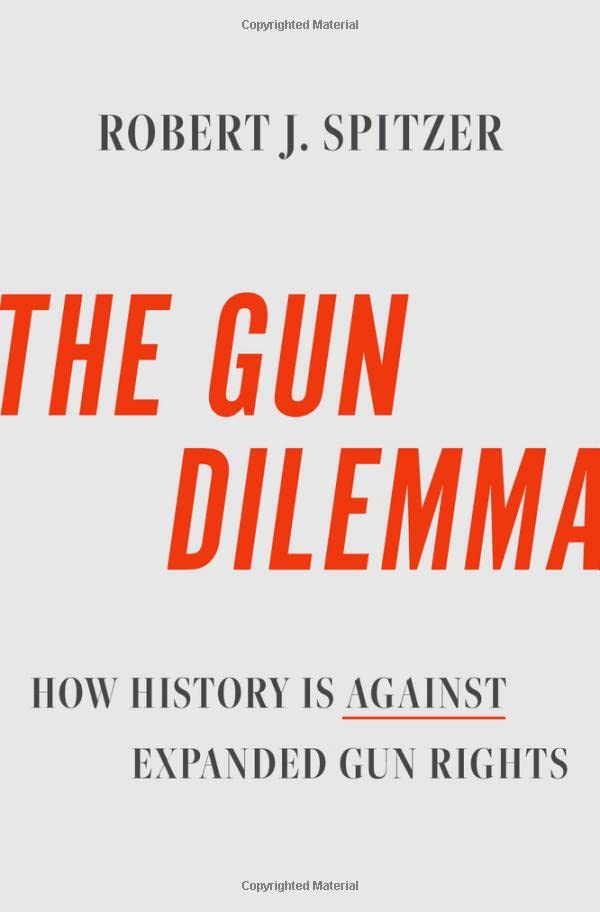Dr. Robert J. Spitzer is the author of 16 books, including four on the presidency and six on gun policy. His latest, The Gun Dilemma: How History Is Against Expanded Gun Rights, published this year, examines contemporary gun controversies, which are rooted in our history – much of which is unknown, ignored, or distorted. In The Gun Dilemma, Spitzer examines, among other things, the effects of the doctrine of constitutional Originalism on the judicial opinions of a new generation of federal judges and their expansive reading of gun rights.
Spitzer also scrutinizes a number of other relevant issues: assault weapons, ammunition magazines, silencers, public gun brandishing and display, and the recent Second Amendment sanctuary movement. In each of these cases he uses the historical record to present a background of facts which contradict the current positions of the gun rights movement.
The notion that restrictions on such lethal weapons like assault weapons are a new assault on long-standing gun rights in this country is shown to be emphatically wrong and represents a deliberate embrace of disinformation. In fact, when the country experienced a surge of gun violence in the 1920s, a number of gun control measures were passed with bipartisan public support. This choice by the American people represented a “Gun Policy Fork in the Road.” But the current policy decisions by the new originalist courts has returned the nation back to a previous era and taken a different, more dangerous course. The divergence of political consensus on gun policy in the first decades of the 21st Century has made the prospect of recalculating our direction in this area ever more difficult.
A related analysis by the author concerns judicial rulings on large capacity magazines, ruling that they are “guns” and protected by a distorted reading of the second amendment. These rulings fly in the face of wide public support for restricting both the weapons and their capacity to fire multiple bullets in a breathtakingly short time. They are the direct consequence of a concerted effort to skew the judicial system so that the designs of a political minority can be realized and an industry (gun manufacturers and sellers) can flourish unimpeded.
The extension of the campaign to arm the public reaches bizarre conclusions, like in the case of the use of silencers. Ostensibly to protect the hearing of shooters from damage, the historical banning of such devices in the 1920s has been overturned. As the author points out, the public at large is then put at risk by being unable to hear gunshots and consequently run away from their source. Again, the welfare of a tiny minority of shooters who choose not to wear ear muffling devices is embraced with disregard for the safety of the majority.
When it comes to the support for open carry of firearms in all venues, there is a curious confluence of distorted interpretations of both first and second amendment rights. The intimidation of the public is seen itself as a weapon whose infringement violates both amendments – intimidation is seen as free speech, and any restriction on open carry seen as leading down a slippery slope to outright confiscation, which has never been the case or the goal. Indeed, even in the “Wild West,” gunslingers had to relinquish their weapons when they came into town.
Finally, there is the case of local jurisdictions passing symbolic, and in some cases specific regulations that local law enforcement officials should ignore state or federal gun restrictions, declaring themselves “sanctuaries” from such policies. This is an ironic twist, when state “preemption” statutes prevent local municipalities from passing their own restrictions which are stricter than that of the state. This tactic has now been extended to voting rights (see Alabama’s GOP) and international boundaries (see Texas’ floating fences in the Rio Grande).
In all these issues related to the dilemma of how any efforts to reduce the devastating toll of gun violence – a toll which the United States far exceeds any other country in the world – Dr. Spitzer provides thorough documentation in copious footnotes. The book is a working handbook for thoughtful and concerned citizens and voters to use in our country’s ongoing and relentless battle for sane, meaningful, and effective gun safety policies. Hopefully we are not irrevocably beyond the fork in the road. We have made good decisions on gun policy in our historical past. We should be able to make them again. There is a way. All we need is the will and political courage.






